Tanning Ledges: Everything You Need to Know
Updated: August 11th, 2025 | Published: May 24th, 2019
8 min read
By Jason Hughes

Imagine relaxing in water without fully submerging yourself- reading, sipping a drink, or simply unwinding. This isn't a fantasy, but a reality when you have a pool with a tanning ledge, also known as a sun shelf or baja shelf. This shallow area lets you enjoy the water without committing to a full swim. It's perfect for cooling off, lounging, or supervising children, making it a versatile and popular pool feature.
What's Inside
Is there a difference between a tanning ledge, tanning shelf, baja shelf, and sun shelf?
What size should a tanning ledge be?
How deep should a tanning ledge be?
Customizing your tanning ledge
Comparing tanning ledges: Concrete vs. Vinyl Liner vs. Fiberglass
How much does a tanning ledge cost?
Is a pool tanning ledge worth it?
What is a pool tanning ledge?
You've probably seen it before but may not know it by name. A tanning ledge (also called a tanning shelf, baja shelf, or sun shelf) is a very shallow shelf in the pool that is usually at least 5 feet wide and 9 inches deep.
This shelf acts as an entry point to your pool and can span its full or partial width. It should be just deep enough for you to be in the water without having to swim or float.
Many people use it to relax, keep cool, read a book, or play. People also like to put furniture on their tanning ledges, including lounge chairs, umbrellas, and even small tables. This type of design has been around for a few years, but it's becoming increasingly popular thanks to its versatility and aesthetic qualities.

At River Pools, we specialize in fiberglass pool manufacturing, but in this article, we’ll break down tanning ledges across all three pool types to give you a better idea of your options. By the end of this article, you should have a good sense of whether a swimming pool with a tanning ledge is the right feature for you and your family.
Pool tanning ledge activities
Tanning ledges are for everyone. Kids love to splash around on them. Adults use them for reading, relaxing, and socializing. Even dogs like to jump in and play! Imagine napping in your lounge chair or having a full meal at the table without having to leave the pool. Swim, eat, nap, repeat. Now that sounds like the life!
Ever feel like getting in the pool, but you're not up for the exercise? We know the feeling. Your tanning ledge gives you the perfect place to cool off on days like these. Besides, with a traditional pool, you would spend most of your time next to the water rather than in it. The tanning ledge gives you the best of both worlds.
Is there a difference between a tanning ledge, tanning shelf, baja shelf, and sun shelf?
These terms all refer to the same thing, and you can use them interchangeably. People typically call it a tanning ledge, a tanning shelf, a sun shelf, a baja shelf, and other names depending on the region. If you ask your pool builder or manufacturer for one of these, they'll likely know what you're talking about no matter what you call it.
What size should a tanning ledge be?
The size of a vinyl liner or concrete pool tanning ledge will vary based on the builder and the design. Generally, it will be at least 5 feet wide with enough space for one or more lounge chairs. You can expect a fiberglass pool tanning ledge to be between 5 and 8 feet wide. This range is what most homeowners prefer as it offers enough space for a few chairs, an umbrella, a cooler, and more.

The depth of your ledge will also vary based on the builder if you’re working with concrete or vinyl liner, but generally, you can expect it to be between a few inches to more than a foot deep. Fiberglass tanning ledges are typically designed to be 9 inches to 18 inches in depth.
It’s important to remember that the depth of your tanning ledge will determine the amount of water that is in it. Typically, there will be about 3 inches of space between the surface of the water and the top edge of the pool. So, a 12-inch deep ledge will give you 9 inches of water.
How deep should a tanning ledge be?
We recommend no more than 9 inches of water, which means that your ledge should be no more than 12 inches deep.
There are several good reasons for this. First, this is a great water depth for small children and pets. It’s also the maximum depth recommended if you ever plan to have furniture (like a lounge chair) in the water. Any more than 9 inches of water and your furniture can float! Not an ideal situation.
Take a look at the illustration below to see how the water depth in your ledge impacts your children, pets, and furniture:

We drew the dog to have the same height as a golden retriever, which is known to be a relatively large breed. If your pet is smaller, try to avoid ledges that are over a foot in depth.
At River Pools, we design our tanning ledges and pools with the homeowner’s needs in mind. That means that all of our tanning ledges are either 9 inches or 12 inches deep, leaving the water at a perfect height for everyone.
Deeper tanning ledges are similar to benches, which offer seating with much more submersion. Some of our models, like our D Series and C Series pools, have benches and a tanning ledge built in so that you can experience them separately and enjoy your pool in a variety of ways.

Customizing your tanning ledge
While you generally have free reign to customize the shape and size of your ledge in a concrete or vinyl liner pool, there are other customization options across all three pool types.
Some of the most popular features are lights and pool bubblers on the tanning ledge. Most people opt for at least one light, but some install two or more.
Bubblers do just what the name implies - they shoot a stream of bubbling water above the pool's surface, creating a fountain effect. Some even come with a light built-in, but these are more expensive than the traditional stand-alone bubbler. As you can probably imagine, kids love to play around bubblers, and they also add the calming sound of running water to your backyard.
Comparing tanning ledges: Concrete vs. Vinyl Liner vs. Fiberglass
You might think that a shelf in a pool is a shelf in a pool no matter how it's made. A lot of people are surprised to learn what a difference the building materials can make and how much they can change their overall experience as pool owners. Read on to discover some pros and cons of putting a tanning ledge in each type of pool.
Concrete
Pros:
- Fully customizable dimensions - create any shape or size.
- Integrate it anywhere in your design.
Cons:
- The rough surface is less than ideal for some while sitting and playing.
Vinyl Liner
Pros:
- Vinyl liner pools are a little bit cheaper to build.
- They feel very pleasant to walk and sit on.
- They’re also fully customizable.
Cons:
- The liner is sensitive to wear and tear, and having a ledge with furniture or pets puts you at risk for leaks, which can result in costly liner replacements.
- Adding a ledge can increase the cost and minimize the money-saving benefit of building a vinyl liner pool.
Fiberglass
Pros:
- The surface of the ledge is smooth to maximize comfort while still offering some slip-resistance.
- You can add a separate fiberglass ledge to your favorite design and gain more swim space.
Cons:
-
- The shape of the manufactured pool or separate ledge is not customizable.
- Not all fiberglass pools are created equal - some manufacturers make tanning ledges that are too deep for furniture, pets, and small children.
Some people find that they get more use out of their pool when they opt for one with a tanning ledge built in. Let’s be honest, swimming and floating is a real workout! Wouldn’t it be nice to have a place in the pool where you can rest? These models also save space and can be easier to install.
Separate fiberglass pools with a tanning ledge are also a popular choice because you can choose the placement of the ledge and decide whether you want it level or slightly elevated (elevating the ledge creates a cool waterfall effect!).

Installing a tanning ledge
When it comes to installing pools with a tanning ledge, fiberglass often offers a time-saving edge compared to concrete or vinyl liner. While adding a tanning ledge to a fiberglass pool usually takes just a few extra hours, other materials like vinyl liner or concrete could extend the installation time by a day or more.
Keep in mind that the building process should be thoroughly discussed upfront during the design phase before the construction of the pool begins.
The installation of a fiberglass pool shell with a tanning ledge is different from traditional pool shell installations. It’s crucial to find out how your installer does this beforehand so that you can assess whether they are doing it right.
A fiberglass pool with a tanning ledge should be installed with additional steps taken to place the tanning ledge on a sturdy foundation. This process involves leaving some earth under the ledge and laying clean, crushed stone underneath. Then, the edges of the shelf are supported with concrete blocks and grout is poured to help fill all voids and create a solid feel when walking across it.
Learn more about how it’s done the right way so that you can compare it to your installer’s method.
How much does a tanning ledge cost?
You deserve to know the cost of every part of your pool project, so grab your pen and paper because here's where we talk numbers.
Vinyl Liner
A vinyl liner tanning ledge may bring additional building and liner customization costs. You should expect a price increase of at least a few thousand dollars to add one to your pool, but only your builder can provide an exact estimate. This does not include the extra hours that you may need to pay the building crew.
Concrete
Integrating a tanning ledge into your concrete pool will naturally cost extra, depending on the square footage of the ledge. For example, let's say that your tanning ledge is going to cover 80 square feet. If your pool costs $100 per square foot, you're looking at an $8,000 tanning ledge. Additional building crew charges may also apply as incorporating the ledge will extend the timeline of the project.
Fiberglass
Choosing a fiberglass pool shell with a tanning ledge built-in could add a bit more for installation. The cost to buy a separate fiberglass tanning ledge can be between $5,000 and $15,000, depending on if it's elevated. If you're looking to save money, your best option might be to choose a model with the ledge built in.
Additional features like bubblers and lights can cost you several hundred more and up per piece across all three pool types, so be sure to save room for them! Even if you'd prefer not to have these features, plan on installing at least one light in your tanning ledge. Summer nights can be perfect for relaxing in the pool, and you won't want to be in the dark.
Want to know more about how fiberglass pools compare to the other two types? Download our free e-book for all the details.
Is a pool tanning ledge worth it?
If you plan on spending a lot of time relaxing in the pool, you may want to consider getting a tanning ledge. We especially recommend it if you plan to have in-pool furniture or if you'll have small children or pets in the water.
If you want to maximize your swimming space for exercise or play, you might want to install a separate ledge next to your pool or skip it altogether.
From the Author: Jason Hughes
I’m Jason Hughes, partner at River Pools® Virginia, and I’ve been working in the pool industry for over 20 years. Over that time, I’ve seen how the right features can completely change the way families enjoy their pools, and tanning ledges are one of the most versatile options out there.
I wrote this article to walk you through what tanning ledges are, how they work, and what they cost, so you can decide if one belongs in your backyard. Whether you’re looking for a place to lounge, a shallow spot for kids and pets, or just a way to get more out of your pool time, I hope this guide gives you the clarity and confidence you need as you plan your project.
Message from the River Pools Manufacturing Team:
When you want to be in the water, but not all the way in, a tanning ledge hits that sweet spot. Whether it's reading with your feet in the water, cooling off without taking a full swim, or keeping an eye on the little ones, this feature brings everyday comfort to your backyard.
As manufacturers of world-class fiberglass swimming pools, we have a large selection of models with and without tanning ledges. View all of our models and check out our pricing guide today to learn more.
Our pools are available through independently owned and operated installers across the country who are here to help you feel confident, informed, and excited about your decision.
Ready to start the conversation?
Jason Hughes is a partner at River Pools Virginia, a fiberglass pool installation company based in Warsaw, Virginia. With over 20 years of hands-on experience, Jason has dedicated his career to helping families create beautiful, functional backyards while ensuring every fiberglass pool installation meets the highest standards of quality and safety. In addition to his work with homeowners, Jason serves as a GENESIS instructor with the Pool & Hot Tub Alliance (PHTA), where he teaches fiberglass pool installation best practices to pool professionals across the country. Whether he’s on a job site or leading a training session, Jason is passionate about raising the bar for fiberglass pool installations and helping families make confident, informed decisions as they transform their outdoor spaces.


